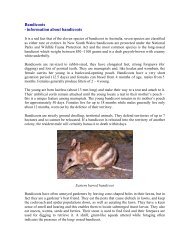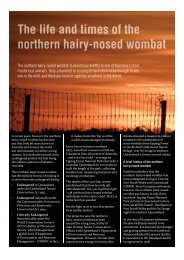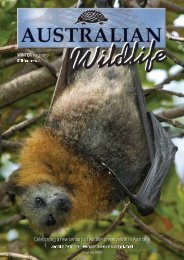Wildlife Preservation Autumn 2012.indd - Wildlife Protection Society ...
Wildlife Preservation Autumn 2012.indd - Wildlife Protection Society ...
Wildlife Preservation Autumn 2012.indd - Wildlife Protection Society ...
Create successful ePaper yourself
Turn your PDF publications into a flip-book with our unique Google optimized e-Paper software.
While I respect the rights of indigenous<br />
people to hunt native animals for<br />
food as bestowed by the Native<br />
Title Act in negotiations with the<br />
elders, I do not agree with it when<br />
there is blatant cruelty in the way<br />
the animals are slaughtered. I doubt<br />
that the authors of the Act foresaw<br />
sanctioning unspeakable cruelty and<br />
I don’t believe that this right comes<br />
without responsibility: particularly<br />
the responsibility to the ‘traditional’<br />
underpinning of this activity – only<br />
take what you need and don’t waste<br />
anything. Establishing a ‘black market’<br />
for the sale of protected marine turtles<br />
and dugongs is not in keeping with the<br />
Native Title Act!<br />
If the laws are changed to bring<br />
indigenous people into line with all<br />
other Australians in terms of animal<br />
cruelty, it would sadly be nearly<br />
impossible to enforce. But, this should<br />
not be used as a cop-out or a failure on<br />
our part to draw attention to these cruel<br />
practices and the killing of protected<br />
wildlife by anyone.<br />
I believe that the laws protecting<br />
our native wildlife and the<br />
condemnation of all animal cruelty<br />
practices must be changed to re ect<br />
the sentiment of the vast majority of<br />
Australians and should be applied<br />
fairly and equally to all Australians<br />
regardless of their racial or ethnic<br />
origins.<br />
This is not a con ict between<br />
indigenous rights and animal rights<br />
activists; it is a con ict between so<br />
called ‘indigenous rights’ and all rightthinking<br />
Australians. Archaic practices<br />
such as the inhumane stone-age killing<br />
of animals with a concrete block have<br />
no place in modern Australia. One<br />
can hardly call ‘traditional hunting’<br />
reasonable when high-powered ri es<br />
and modern fast motor boats are used<br />
to hunt our protected marine wildlife.<br />
Clearly the laws of Australia must apply<br />
for all Australians equally – with no<br />
exemptions to anyone.<br />
The recent state election in Queensland<br />
brings promise that the newly-elected<br />
Minister for the Environment will<br />
Australian <strong>Wildlife</strong> Vol 2 - <strong>Autumn</strong> 2012<br />
From the President’s desk<br />
Suzanne Medway - President<br />
Traditional hunting of native wildlife -<br />
no place in the 21 st Century<br />
challenge issues of cruelty in the killing<br />
of native wildlife under the Native Title<br />
Act.<br />
I have now written to the Federal<br />
Minister for the Environment<br />
requesting him to enforce a total<br />
ban on the hunting of all protected<br />
native wildlife and, in particular, a<br />
total ban on the hunting of native<br />
marine life in green zones anywhere<br />
in Australia.<br />
Spider wars<br />
In the last magazine we featured an<br />
interesting article entitled “Spider<br />
wars”. Helen Smith, Research Associate<br />
in Arachnology at the Australian<br />
Museum wrote:<br />
“I wanted to send you some information<br />
on the mystery Theridion spider<br />
recorded by John Merrick and featured<br />
in your Summer issue (pp 30-31).<br />
“The long-legged species in question<br />
is a native Australian spider, currently<br />
called Theridion gigantipes. This<br />
species was originally described<br />
from Sydney but has frequently been<br />
mis-identi ed as the introduced<br />
grey house spider, Parasteatoda<br />
tepidariorum (previously in the<br />
genus Achaearanea).<br />
“The prey, ‘Blacky’ is indeed a<br />
black house spider, Badumna<br />
insignis. Theridion gigantipes has often<br />
been recorded eating other spiders<br />
as well as a wide variety of insects.<br />
The territory around windows, where<br />
insects are attracted by lights at night,<br />
seems to be ‘hot property’ and quite a<br />
few spider species commonly interact in<br />
such areas.<br />
“The nal two shots of John’s sequence<br />
do not show a male, but another<br />
female with her recently emerged<br />
spiderlings. If ‘Nimble-foot’ had strayed<br />
too close there would have been a<br />
show down! Incidentally, the males<br />
of T. gigantipes can be recognised by<br />
enlarged palps, even longer legs, and a<br />
more elongate body. Males are often to<br />
be found lurking in or near female and<br />
juvenile female webs.<br />
“Myself and several colleagues<br />
have recently submitted a paper to<br />
redescribe Theridion gigantipes and<br />
place the species into a di erent genus.<br />
I actually came across your article on<br />
the day our paper was ready to submit<br />
so was able to include a reference. Once<br />
the paper is published I will be happy to<br />
send you further information.”<br />
University grants<br />
One of the great pleasures of my time as<br />
President has been meeting and learning<br />
from the university grant winners. While<br />
I have not had the privilege of meeting<br />
all of the winners, I have got to know<br />
them through their articles for this<br />
magazine and their emails. I was very<br />
sad to learn that Paul Chachelle, one of<br />
our winners in 2011, died recently. Paul’s<br />
project article was published in the last<br />
edition of Australian <strong>Wildlife</strong>, Spring<br />
(pp 22-23). We will sadly miss Paul and<br />
his valuable contribution to the science<br />
of wildlife preservation. The family<br />
asked that in lieu of owers, donations<br />
be made to the <strong>Wildlife</strong> <strong>Preservation</strong><br />
<strong>Society</strong> of Australia.<br />
Senior’s Environmental Award<br />
I was very humbled and proud to<br />
receive a 2012 NSW Seniors Week<br />
Achievement Award in the category<br />
Environment, Science, Agriculture.<br />
My family and nominator accompanied<br />
me to the award presentation and<br />
cheered me on as I accepted the award<br />
from Graham Ross, the NSW Seniors<br />
Week Ambassador for this category.<br />
Suzanne and Patrick Medway admiring the new<br />
award<br />
5





